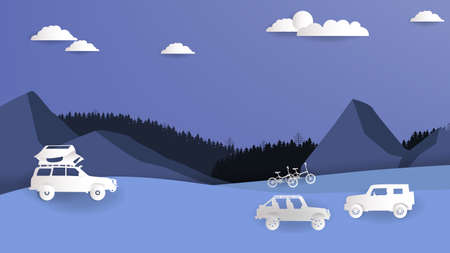1. Prepare Your Vehicle for the Trip
Before taking off on a long road trip, its crucial to make sure your car is in top shape. A well-maintained vehicle not only ensures a smooth ride but also keeps you safe on the road.
Check Your Tires
Your tires play a major role in your car’s safety and fuel efficiency. Check the tire pressure using a gauge and inflate them to the recommended PSI. Also, inspect the tread depth to ensure proper traction. If your tires show excessive wear, consider replacing them before your trip.
Monitor Your Oil Levels
Engine oil keeps your car running smoothly by reducing friction and heat. Check the oil level using the dipstick and add oil if needed. If it’s been a while since your last oil change, consider getting one before heading out.
Inspect Brakes and Lights
Brakes are essential for safe driving. If you hear squeaking or feel vibrations while braking, get them checked by a mechanic. Also, ensure that all lights—including headlights, brake lights, and turn signals—are working properly.
Pre-Trip Maintenance Checklist
| Component | What to Check |
|---|---|
| Tires | Pressure, tread depth, and any visible damage |
| Oil | Check level and change if necessary |
| Brakes | Listen for noises and check brake response |
| Lights | Ensure all lights are functioning properly |
Final Preparations
After checking these key components, take your car for a short test drive. If anything feels off, don’t ignore it—have a professional inspect it before you leave. Ensuring your vehicle is in peak condition will help you avoid breakdowns and unnecessary stress during your road trip.
2. Plan Your Route and Stops
Before hitting the road, take time to map out your trip. Planning your route helps ensure a smooth and safe journey. Youll want to know where youre going, the best roads to take, and where to stop for breaks.
Use GPS or Maps
Whether you prefer a GPS app on your phone or a physical map, having your route planned in advance can prevent unnecessary stress. A GPS can give real-time traffic updates, while a paper map is a great backup in case of no signal or a phone battery issue.
Plan Rest Stops
Driving for long periods can be exhausting, so scheduling regular rest stops is essential. Aim to stop every two hours or every 100 miles to stretch, grab a snack, and stay alert. Rest areas, parks, and diners make great stopping points.
Locate Gas Stations
Running low on gas in an unfamiliar area can be stressful. Before your trip, mark gas stations along your route, especially in rural or remote areas where stations may be sparse. This helps you avoid unnecessary delays or getting stranded.
Find Emergency Services
Its always good to be prepared for unexpected situations. Identify nearby hospitals, urgent care centers, and mechanics along your journey. Knowing where to go in case of an emergency can save valuable time.
Sample Route Checklist
| Essential Stops | What to Look For | Recommended Frequency |
|---|---|---|
| Rest Stops | Safe parking areas, clean bathrooms, food options | Every 2 hours or 100 miles |
| Gas Stations | Multiple pumps, open 24/7 if possible | Before tank goes below 1/4 |
| Emergency Services | Hospitals, urgent care centers, police stations | Every major city or town along the route |
By carefully planning your route and identifying stops ahead of time, you can stay focused on the road and enjoy your trip with more confidence.

3. Practice Safe and Defensive Driving
When youre a teen driver going on a long road trip, staying safe behind the wheel should always be your top priority. Defensive driving helps you react to unexpected situations and reduces the chances of accidents. Follow these key safe driving practices to keep yourself and others safe on the road.
Maintain a Safe Following Distance
Keeping a safe distance between your car and the vehicle in front of you gives you more time to react if traffic suddenly slows down or stops. A good rule of thumb is the “three-second rule.” Pick a stationary object on the side of the road, like a sign or a tree, and when the car in front of you passes it, count to three. If you reach the object before you finish counting, youre following too closely and should increase your distance.
| Speed | Recommended Following Distance |
|---|---|
| Under 30 mph | At least 2 seconds |
| 30-60 mph | At least 3 seconds |
| Over 60 mph | At least 4 seconds |
Obey Traffic Laws
Traffic laws are there to protect everyone on the road. Always follow speed limits, use your turn signals, and respect road signs and traffic lights. Speeding may save you a few minutes, but it also increases the risk of crashes and can lead to hefty fines or worse—serious accidents. Make it a habit to drive within the law, even if others around you are being reckless.
Stay Aware of Other Drivers
Not every driver on the road is as cautious as you are, so always be alert. Watch for sudden lane changes, distracted drivers, and aggressive behavior from others. Check your mirrors frequently and keep an eye on blind spots. If you notice someone driving dangerously, give them extra space and avoid engaging with them to prevent road rage situations.
Signs of a Distracted or Reckless Driver
- Swerving between lanes
- Not maintaining a consistent speed
- Sudden braking or acceleration
- Using a phone or looking away from the road
Tip:
If you ever feel tired or overwhelmed while driving, take a break. Find a safe place to pull over, stretch, and rest before continuing your trip.
4. Manage Fatigue and Stay Alert
Driving for long hours can be exhausting, especially for teen drivers who may not have much experience with extended trips. Fatigue can slow your reaction time and make it harder to focus on the road. To stay alert and drive safely, follow these essential tips:
Take Regular Breaks
Driving non-stop for hours increases the risk of fatigue, which can lead to dangerous situations. The best practice is to take a break every 2 hours or every 100 miles, whichever comes first. Use these breaks to stretch, walk around, or even take a short nap if needed.
Stay Hydrated
Dehydration can cause headaches, dizziness, and tiredness, all of which affect your ability to drive safely. Make sure to drink plenty of water throughout your trip. Avoid excessive caffeine, as it may boost alertness for a short time but can lead to a crash in energy later.
Avoid Driving for Long Hours Without Rest
It might be tempting to push through a long drive without stopping, but this can be dangerous. If possible, share driving responsibilities with a friend or family member. If youre traveling alone, set a limit on the number of hours you drive each day to avoid burnout.
Signs of Driver Fatigue
If you experience any of the following signs, it’s time to pull over and take a break.
| Signs of Fatigue | What to Do |
|---|---|
| Frequent yawning | Drink water, get fresh air, or take a short nap. |
| Heavy eyelids or blinking often | Stop at a rest area and take a 15-20 minute nap. |
| Drifting between lanes | Switch drivers or take an extended break. |
| Struggling to keep your head up | Find a safe place to rest before continuing. |
Plan for Overnight Stops
If your road trip requires more than 8-10 hours of driving, consider planning an overnight stay. Booking a hotel or stopping at a rest area gives you time to recharge, improving your focus for the next days drive.
5. Five. Prepare for Emergencies
When youre hitting the road as a teen driver, being prepared for emergencies can make a huge difference. No one wants to deal with car trouble, but it’s always best to be ready just in case. Here are some key things to do before starting your trip.
Carry an Emergency Kit
Having an emergency kit in your car can help you stay safe in unexpected situations. Make sure your kit includes essentials like:
| Item | Purpose |
|---|---|
| First Aid Kit | For treating minor injuries |
| Flashlight & Batteries | To help you see in the dark |
| Jumper Cables | For restarting a dead battery |
| Basic Tools | Useful for small repairs |
| Emergency Contacts List | Important numbers in case of an emergency |
| Water & Snacks | To stay hydrated and energized |
| Blanket | For warmth if you need to wait for help |
Have Roadside Assistance Contacts Ready
Before you start your trip, save all necessary emergency contact numbers in your phone, including roadside assistance services and an emergency contact person. Many drivers use AAA or other roadside assistance programs, which can help with towing, flat tires, and battery jumps.
Know How to Handle Common Car Issues
Understanding how to deal with common car problems can help you stay safe and avoid stressful situations. Here are some basic troubleshooting steps:
Flat Tire
- Pull over to a safe spot away from traffic.
- Turn on your hazard lights.
- Use a jack and spare tire to replace the flat, or call for roadside help if needed.
Dead Battery
- Use jumper cables with another vehicles battery.
- Connect red cable to positive terminals and black cable to negative terminals.
- Start the working car first, then try starting yours.
- If the car won’t start, call roadside assistance.
Engine Overheating
- Turn off the AC and pull over safely.
- Let the engine cool before opening the hood.
- Check coolant levels; if low, add more coolant.
- If overheating continues, call for help.
By being prepared for emergencies, you can focus on enjoying your road trip with confidence. Planning ahead and knowing how to handle common car issues can help you stay safe and avoid unnecessary stress.


